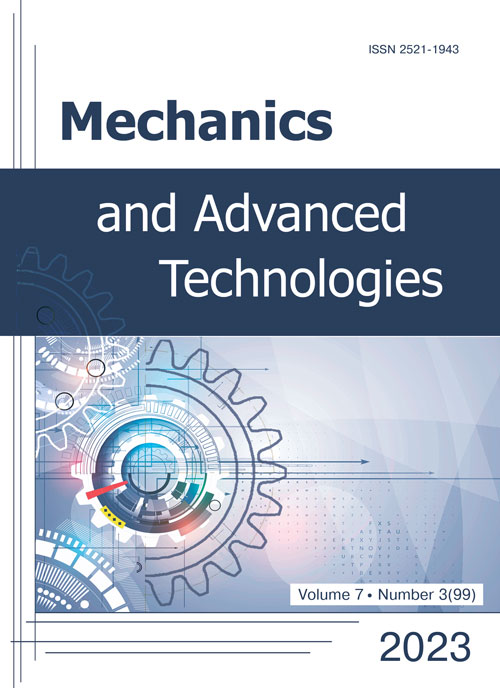Prediction of drag coefficient of a hybrid body design of aircraft
DOI:
https://doi.org/10.20535/2521-1943.2023.7.3.284872Keywords:
Finite element analysis, ANOVA, Hybrid design aircraft, computer aided design, drag reductionAbstract
This study presents a design of a quintessential hybrid body aircraft, a blended NACA 4414 airfoil winged body. The Design of Elements approach, via Response Surface Methodology (RSM), is used to evaluate the influence of frontal area, chamber angle and materials on the drag coefficient. The Analysis of Variance (ANOVA) is carried out to find the influences of the same. In order to minimize the simulations, a model in RSM, Central Composite Design (CCD) is used. The results of the same are verified via Computational Fluid Dynamics (CFD) simulations. Moreover, combinations of shape memory polymers with composites and graphene nano powder are proposed, for light-weighting and enhanced mechanical properties. A comparison of said materials with commercially used aluminum alloys is done. It is found that the lowest drag coefficient is achievable at a frontal area of 1625 m2 with an angle of attack of -10o and with a material combination of carbon fiber reinforced polymer, glass fiber reinforced polymer, and 10% graphene nano powder by weight.
References
- Commercial Aircraft Propulsion and Energy Systems Research: Reducing Global Carbon Emissions. Washington, DC: National Academies Press, 2016. DOI: https://doi.org/10.17226/23490.
- E. B. Salas, Commercial airlines: worldwide fuel consumption 2005–2022. Available at: https://www.statista.com/statistics/655057/fuel-consumption-of-airlines-worldwide/.
- Net zero carbon emissions by 2050, International Air Transport Association, 2021. Available at: https://www.iata.org/en/pressroom/pressroom-archive/2021-releases/2021-10-04-03/.
- R. P. Liem, J. R. Martins and G. K. Kenway, “Expected drag minimization for aerodynamic design optimization based on aircraft operational data”, Aerospace Science and Technology, vol. 63, pp. 344–362, 2017. DOI: https://doi.org/10.1016/j.ast.2017.01.006.
- L. Zhu, N. Li, and P. R. N. Childs, “Light-weighting in aerospace component and system design”, Propulsion and Power Research, vol. 7, no. 2, pp. 103–119, 2018. DOI: https://doi.org/10.1016/j.jppr.2018.04.001.
- R. H. Liebeck, “Design of the blended wing body subsonic transport”, Journal of Aircraft, vol. 41, no. 1, pp. 10–25, 2004. DOI: https://doi.org/10.2514/1.9084.
- Y. Staelens, R. Blackwelder, and M. Page, "Novel pitch control effectors for a blended wing body airplane in takeoff and landing configuration", in 45th AIAA Aerospace Sciences Meeting and Exhibit, Reno, Nevada, 2007. DOI: https://doi.org/10.2514/6.2007-68.
- A. R. Ikram, Numerical Investigation of Leading-Edge Modifications of a NACA Airfoil, Masters Theses, 2020. Available at: https://scholarworks.gvsu.edu/theses/976.
- NACA 4 digit airfoil generator (NACA 2412 AIRFOIL). Available at: http://airfoiltools.com/airfoil/naca4digit.
- V. H. Wilson, S. S. Mohamed, K. Tyagi, V. Gupta and J. Swaminathan, “A Development of Innovative Shape Memory Polymers and Their Nanocomposites to Resist the Load Aircraft High Lift Devices”, International Journal of Advanced Research in Engineering and Technology, vol. 11, no. 9, pp. 14–35, 2020. Available at: https://ssrn.com/abstract=3708660.
- D. Ratna and J. Karger-Kocsis, “Recent advances in shape memory polymers and composites: a review”, Journal of Materials Science, vol. 43, no. 1, pp. 254–269, 2008. DOI: https://doi.org/10.1007/s10853-007-2176-7.
- Y. Liu, H. Du, L. Liu and J. Leng, “Shape memory polymers and their composites in aerospace applications: a review”, Smart materials and structures, vol. 23, no. 2, p. 023001, 2014. DOI: https://doi.org/10.1088/0964-1726/23/2/023001.
- Y. Yining, “Analysis of the Influence of Camber on Hydrodynamic Characteristics of Airfoil Based on FLUENT”, Journal of Physics: Conference Series, vol. 1519, no. 1, p. 012020, 2020. DOI: https://doi.org/10.1088/1742-6596/1519/1/012020.
- N. Couto, V. Silva, J. Cardoso, L. M. González-Gutiérrez and A. Souto-Iglesias, “Coupled CFD-response surface method (RSM) methodology for optimizing jettability operating conditions”, ChemEngineering, vol. 2, no. 4, p. 51, 2018. DOI: https://doi.org/10.3390/chemengineering2040051.
- A. Jankovic, G. Chaudhary and F. Goia, “Designing the design of experiments (DOE) – An investigation on the influence of different factorial designs on the characterization of complex systems”, Energy and Buildings, vol. 250, p. 111298, 2021. DOI: https://doi.org/10.1016/j.enbuild.2021.111298.
- E. Ostertagová and O. Ostertag, “Methodology and application of oneway ANOVA”, American Journal of Mechanical Engineering, vol. 1, no. 7, pp. 256–261, 2013.
- D. C. Montgomery and G. C. Runger, Applied statistics and probability for engineers. Hoboken, NJ: John Wiley & Sons, 2011, 768 p. Available at: https://industri.fatek.unpatti.ac.id/wp-content/uploads/2019/03/088-Applied-Statistics-and-Probability-for-Engineers-Douglas-C.-Montgomery-George-C.-Runger-Edisi-5-2011.pdf.
- A. E. Ockfen and K. I. Matveev, “Aerodynamic characteristics of NACA 4412 airfoil section with flap in extreme ground effect”, International Journal of Naval Architecture and Ocean Engineering, vol. 1, no. 1, pp. 1–12, 2009. DOI: https://doi.org/10.3744/JNAOE.2009.1.1.001.
- J. Sun, J. M. Hoekstra and J. Ellerbroek, "Aircraft drag polar estimation based on a stochastic hierarchical model", in Eighth SESAR Innovation Days 2018, Salzburg, Austria, 2018. Available at: https://www.sesarju.eu/sites/default/files/documents/sid/2018/papers/SIDs_2018_paper_75.pdf.
- Aircraft Design - an Open Educational Resource (OER) for Hamburg Open Online University (HOOU). Available at: https://www.fzt.haw-hamburg.de/pers/Scholz/HOOU/AircraftDesign_13_Drag.pdf.
- U.S. Standard Atmosphere vs. Altitude. The Engineering ToolBox, 2003. Available at: https://www.engineeringtoolbox.com/standard-atmosphere-d_604.html.
- M. A. Saber, M. S. Helal and A. Mohsen, "Aerodynamic Study of Airbus 320 Airplane Model for Hands-on Learning", in 4th IUGRC International Undergraduate Research Conference, Cairo, Egypt, 2019. Available at: https://www.academia.edu/39998960/Aerodynamic_Study_of_Airbus_320_Airplane_Model_for_Hands-on_Learning.
Downloads
Published
How to Cite
Issue
Section
License
Copyright (c) 2023 Venkatachalam Gopalan

This work is licensed under a Creative Commons Attribution 4.0 International License.
Authors who publish with this journal agree to the following terms:
- Authors retain copyright and grant the journal right of first publication with the work simultaneously licensed under CC BY 4.0 that allows others to share the work with an acknowledgement of the work's authorship and initial publication in this journal.
- Authors are able to enter into separate, additional contractual arrangements for the non-exclusive distribution of the journal's published version of the work (e.g., post it to an institutional repository or publish it in a book), with an acknowledgement of its initial publication in this journal.
- Authors are permitted and encouraged to post their work online (e.g., in institutional repositories or on their website) prior to and during the submission process, as it can lead to productive exchanges, as well as earlier and greater citation of published work











